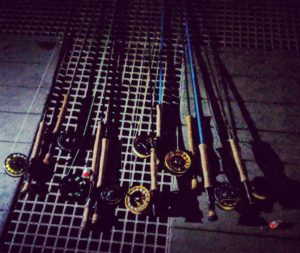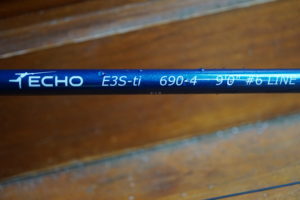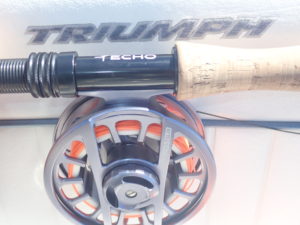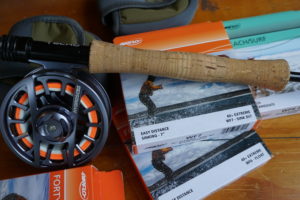Gear

A pile of rods rigged and ready for a day of saltwater fly fishing. I don’t generally bring THIS many rods with me, but I’m not afraid to bring however much gear I feel I need for a successful day.
Lets face it… As fly fishers we love gear. We love fishing with it, practicing with it, fiddling with it at home, reading about it, talking about it…. We flat out love gear. I sure do! In fact gear related questions probably out number every other type of question I ever receive from people. “What rods do you use for fly fishing Puget Sound?” “What’s your favorite saltwater reel?” “What’s your favorite line for fly fishing Puget sound” etc etc etc. With that in mind I thought I’d use this blog post to discuss the gear that I use most frequently on my South Sound Skiffs trips on Puget Sound.
Now I need to preface this by saying that a huge part of gear selection is subjective. What I like, and what works best for me and my style of fishing/guiding may be completely different from what works for someone else. Ultimately no matter what anyone tells you, there is no “right” or “wrong”, “best” or “worst” when it comes to fly fishing gear. It all comes down to what you like, and what works best for the fishing that you do. Some anglers absolutely love to fish bamboo or fiberglass rods, floating lines, long leaders, and surface patterns. If this is your preferred method of fishing then a fast action, graphite, saltwater fly rod is probably not going to be your tool of choice. On the opposite end of the spectrum, as someone who fishes a lot of heavy flies, fast sinking lines, and fishes in just about all weather conditions, a light and soft bamboo rod just isn’t going to cut it for me, and is not the type of rod you will find in my boat at any given time.
So with that said I’m just going to jump right in to discussing the gear that you will most often find in my boat during a South Sound Skiffs trip.
For my trips I provide all gear as needed. Rods, reels, lines, leaders, flies…. I provide it all. Of course my guests are absolutely welcome to bring their own gear, and they often do, but a large percentage of the people I take out haven’t done this type of fishing much, and its pretty unrealistic to expect people to go out and buy a bunch of new gear specific to this fishery just so they can come out and fish with me. I am a big believer in having the right tool for the job, and I strongly believe that the correct gear will give any fly angler the highest chance of success in an ever changing saltwater environment.

My go to saltwater fly rod…. Echo S3 690-4
Rods
If I am taking 2 anglers out who are not bringing any of their own gear, I will generally bring 4-6 rods strung up and ready to fish. I have a wide variety of rods for various purposes… I have high end, super fast action saltwater rods for those with experience casting such rocket ships, I have medium-fast saltwater rods for people with a more relaxed stroke, and I even have a couple glass rods that I will bring out for certain occasions. I own and fish many different rods by many different rod manufacturers, but without a doubt my favorite rods for day in and day out guided fishing on Puget Sound are made by Echo. Echo makes absolutely incredible fishing rods at price points that will fit any budget. I own and fish a wide variety of Echo rods. They get fished hard day in, day out, often by people with little to no experience, and they take a beating. The Puget Sound saltwater environment is brutal on gear, and I am not easy on my gear as it gets thrown in and out of the boat, laid down over the gunnels, dropped on the deck of the boat etc. Echo rods have proven to hold up extremely well to this abuse, and in the rare instance where I have broken or damaged a rod, Echo’s customer service truly shines. Echo is a local company, and while their rods are made over seas, they are extremely well made and I enjoy dealing with a company based in the Pacific Northwest.
On an average Puget Sound trip I will have (4) Echo S3 Saltwater 9′ 6 wt rods rigged and ready. If you were to stop my boat at any given time during one of my trips, there is a very good chance these are the rods you will find in my boat. I find these rods to be perfectly suited to this environment, and the style of fishing I tend to focus on. They are just as capable throwing type 7 shooting head lines and heavy clouser minnows as they are throwing floating lines and poppers. These rods just flat out do it all. They look nice, feel nice in hand, have plenty of power, and have a tremendous amount of feel. I will typically have these rods rigged as such: 2 rods rigged with full intermediate lines, and two rods rigged with faster sinking lines. My line choice, at least for what I will have rigged and ready starting out for a day, is generally based on the areas I plan to fish, and the tides. If I’m planning to target some shallow oyster beds for sea run cutthroat, I will often have two rods rigged with full intermediate lines, and 2 rods rigged with floating lines. If I plan to target resident coho in deeper water and fast currents, I will usually have two rods rigged with type 3 lines, and two rods rigged with type 7 lines. While the line selection changes from day to day, the rod selection doesn’t. These S3 rods are capable of handling any line I throw on them, including over lining. If I know I am taking out someone brand new to fly fishing I will generally rig my 6 wt Echo S3 rods with 7 wt lines just to allow a new caster to get a feel for the rod loading up with less line in the air. Having a rod that has the ability to handle over lining is important for my needs, and these rods handle heavier lines with ease. I own a total of eight of these S3 rods in the 9′ 6 wt variety… Yeah, I love them that much! At a retail point of around $400 these things are a steal, and perform as well, if not better, than rods casting twice as much.
A couple other Echo rods that I will often bring out on my trips are as follows:
Echo Ion- I own two of these in a 9′ 6 wt configuration, and I will often bring these rods when I know my guests have little to no fly fishing experience. The action on these rods tends to lean a bit more towards the medium side of things, which can be easier for new fly casters to learn on. These rods retail for about $170 and I’m not sure there is a better rod going for the price point. They aren’t as light as the S3, but from a pure fishing tool perspective these rods are fantastic. They too will handle being over lined just fine, and whenever I pick up one of these rods I am blown away by how well they cast and fish at this price point. I like to have rods of varying actions so that when I am working with inexperienced fly casters I can work with them and different rod setups to help find a rod that will really match up well to their ability. These medium-fast Echo Ions are a tremendous value, and are just an excellent fishing tool. Whenever I get asked for a rod suggestion by a new fly angler looking to get into the sport without breaking the bank, these are the rods I recommend.
Echo Bad Ass Glass- These are my fun rods. I own a couple of 8′ 6 wt Echo Bad Ass Glass rods and while I don’t bring them out on every trip, these are the rods I bust out for special situations, or guests who I know will appreciate them. These are the first fiberglass rods I’ve ever owned, but let me tell you these are not your grandfather’s old fiberglass rods! These things feel like a typical glass rod in hand, very noodly, but when you actually line them up and start casting them they will blow your mind. These things throw darts! These are probably the most pure “fun” rods I’ve ever cast/fished. They take a little getting used to, because while these are definitely fast compared to most fiberglass rods, when compared to a standard fast action graphite they are definitely a lot slower. For folks with some casting experience who are able to slow down and adjust their casting stroke to match these rods, they are an absolute blast to fish. I tend to fish these rods with floating or intermediate lines, generally on calmer wind days, and they are just a joy to fish. A 15″ sea run cutthroat will feel like an absolute pig on one of these rods, but they also have a surprising about of fish fighting backbone and as such still allow us to land and release these fish quickly which is of ultra importance to me. I do not fish 3 wt rods on Puget Sound because I respect these fish far too much. I believe in landing them as quickly as possible, and sending them on their way. These rods are just plain fun! If you’re looking for a niche type of fun rod, these are flat out hard to beat. I challenge anyone to catch a bunch of resident coho on one of these rods without a giant smile appearing on their face. Go ahead… I dare you!
The other rod company that I am a big fan of is Scott. Although I don’t use their rods for my guide trips anywhere near as often as Echo, I am a big fan of both the Scott Meridian and Radian. I own a 9′ 6 wt Meridian, a 9′ 6 wt Radian, and a 9′ 6″ 6 wt Radian and these are the rods I bring out for people with a high amount of fly fishing experience who wish to fish a truly high end fly rod for a day. The Meridian is an incredibly powerful rod that handles heavy flies, fast sinking lines, and any fish Puget Sound has to offer. The Radian is also a fast rod, but has a much different tip that is tough to put into words but absolutely incredible in action. In my opinion one of the benefits of hiring a guide is the ability to play with and fish gear that you may not be familiar with, so I like to have these super high end rods available as options for those who choose to go that route.

The Echo S3 combined with the Orvis Hydros SL reel is a fantastic combo for Puget Sound fly fishing
Reels
I’ve used many, many different saltwater fly reels over the years, and I am a big fan of several companies. Galvan, Nautilus and Bauer make some of my absolute favorite saltwater fly reels, however for my business I have found one reel that is absolutely perfect in many ways, and that’s the Orvis Hydros SL. The Hydros SL III, which is the perfect size for the 6 wt rods that I use, retails for about 219 bucks and is flat out the best value in saltwater fly reels that I’ve ever found. I own a whole pile of these reels with a bunch of extra spools, and they will be found on all of my rods on any South Sound Skiffs trip. They have a drag that is incredibly powerful and smooth, and can be adjusted to exactly the right position. They are machined and built with extremely high quality, and these things will just take a beating. If you do a Google search for reviews of these reels you will see that they have held up quite favorably to reels costing 2-3 times as much, and in many cases flat out perform more expensive reels. They are light weight, hold plenty of backing, have a drag that will stop any fish that swims in our waters up to and including adult chinook and chum salmon, and are tough as nails. My reels take a beating on a daily basis, and these reels take whatever we can throw at em and just keep going. A fly angler can spend a lot more money on a Puget Sound saltwater fly reel, but it’s going to be tough to find a reel that offers a significant advantage over the Hydros SL at ANY price point. I cannot say enough good about these reels, and I recommend them without hesitation every single time the topic of saltwater fly reels comes up. My one and only complaint with these reels, and it seems to be a common complaint from what I’ve read, is the drag knob is not terribly well designed. It has a flat, thumb grip spot on the drag knob that is just flat ridiculous and makes adjusting the drag while fighting a fish a bit cumbersome. Ultimately this is not a big deal to me, as its more of a nuisance than anything, and quite frankly for the fish we encounter in Puget Sound it’s not often that we have to make many drag adjustments during the fight. This is my only complaint, and its a minor one, but it is worth noting. If you’re looking for a rock solid saltwater fly reel that isn’t going to break the bank, yet will perform flawlessly for years to come, you just can’t beat the Orvis Hydros SL.

Echo rods, Orvis Reels, and Airflo lines……All my favorites!
Lines
The last bit of gear I’m going to discuss here is fly lines. I truly believe that line selection is the most important factor for this fishery. Much more important than the rod or reel, the correct line is what is going to make or break any fishing trip on Puget Sound. When fly fishing Puget Sound from a boat we will often be fishing many different types of water throughout the course of a day. We may start out fishing shallow oyster beds and creek mouths with little current, then transition to fishing steeper, heavily structured beaches with swift, steady current, and then perhaps move out and fish deeper water in heavy, swirling rip currents while targeting coho. I strongly believe in having the right line for every scenario, so no matter the trip I carry a total of 10 lines all on reels/spools. I know these seems a bit excessive, but there is nothing worse than encountering a scenario on the water where I don’t have the right line for the fishing at hand. I never want to be caught in that situation, and I never want to be accused of being unprepared, so along with the reels/lines strung up on the rods I bring with, I will have the rest of these reels and lines tucked away inside my boat bags.
When it comes to line manufacturers there is one king for our Puget Sound fishery, and that is without a doubt Airflo. In particular, the Airflo Beach Line and the 40+ lines are what I use exclusively. As far as I’m concerned Airflo makes the absolute best casting, most durable lines for this fishery and its not even close. These guys produce a high quality line that is going to last a long time. As someone who spends a LOT of time on the water during the course of the year it is important to me that my lines are going to hold up to heavy use, and no line I’ve ever used does so better than Airflo.
For any trip on Puget Sound I will have the following lines either rigged up, or stashed on reels in my boat bag:
(2) Airflo full intermediate Beach lines. These are my go to intermediate lines, and they get used an awful lot. I prefer the Beach Line for intermediate lines over the 40+ because the Beach Line is available in a full intermediate version. (The head AND running line sink at an intermediate sink rate). I am not a fan of intermediate lines that have an intermediate head and a floating running line. The main reasons being that a floating running line will get pushed around by even the smallest amount of wind chop, resulting in small bits of slack line that can deter an angler from feeling a sensitive take and prevent solid hooksets. I much prefer an intermediate running line that will get beneath the surface chop and keep a tight line connection all the way to the fly. Floating running lines also have a tendency to pick up seaweed and other floating debris much more so than the intermediate version that will sink below stuff that is floating along the surface. These are an integrated shooting head style line, which I find perfectly suited to the type of fishing I do. Integrated shooting heads minimize false casting, and are designed to throw heavy flies while dealing with the variety of wind and elements common in saltwater fly fishing.
(2) Airflo 40+ Floating lines. I use these lines for any topwater fishing… Poppers, gurglers, sliders etc. If I need to fish on top the 40+ floater is what I’m stringing up. These lines cast amazingly well, will turnover larger poppers with ease, and have great durability. These are also my go to lines for fishing long leaders and small euphasid type patterns when fish are sipping at the surface as they often do during the winter.
(2) Airflo 40+ Type 3 lines. I reach for these lines anytime I am dealing with current that is just too heavy for the intermediate lines, anytime I need to achieve just a bit more depth, and often times when I’m fishing unweighted/neutrally buoyant flies because I like the action given to many of these patterns when pulled down a little deeper by the type 3 line.
(2) Airflo 40+ Type 5 lines. These are the lines that I use the least often, but when I need this particular line it is often the difference between a very good day of catching, and a mediocre day. I use these lines when fishing deeper/steeper beaches with heavy current when the type 3 is not quite enough to get down and the type 7 is just too much. I don’t find myself in these scenarios all that often, but when I do it is very nice to have the right line to handle it. These also fish deeper water rips for coho and chinook extremely well.
(2) Airflo 40+ Type 7 lines. These are my go to for super heavy currents, and fishing deep water. Whenever I’m targeting coho in strong rips that are out in deeper water, these are the lines I reach for first. I also use these lines a lot when casting to the beach for sea run cutthroat in places where there is really heavy tidal current. These are incredibly useful lines when fly fishing from a boat, and I wouldn’t dream of leaving the dock without them.
I carry all 10 of these lines every single time I leave the dock. I understand that not everyone is going to want, or be able, to carry this many lines with them and that’s fine. However for me I like to be prepared for any situation I might encounter, so I find it’s worth the effort. I am able to stash all the extra lines/reels in my boat bag so they don’t take up much room, and are there when I need them. As I mentioned above, the correct line is often the difference between an ok day and a stellar day, and I am willing to do whatever it takes to be able to adjust to the varying conditions we encounter throughout any single trip on Puget Sound. There are a lot of line manufacturers out there, but in my opinion none of them are making a better line for our fishery than Airflo.
So there is a run down on the gear that I carry and use most often on my South Sound Skiffs guided trips. Your opinion may vary completely, and what works well for me may not be your first choice and that’s fine. Hopefully this helps give people an idea of the gear that I prefer and why, and perhaps will help some of you make informed purchases of your own gear in the future.
I love to discuss gear, so I’d definitely love to hear your thoughts and experiences. I don’t claim to be an authority on this fishery by any means, and no matter how many days I spend on the water I am constantly trying to learn and better myself as an angler and guide. If you have a piece of gear that you feel excels in this fishery, I’d love to hear about it! Leave me a comment and let’s discuss!
Tight lines!
